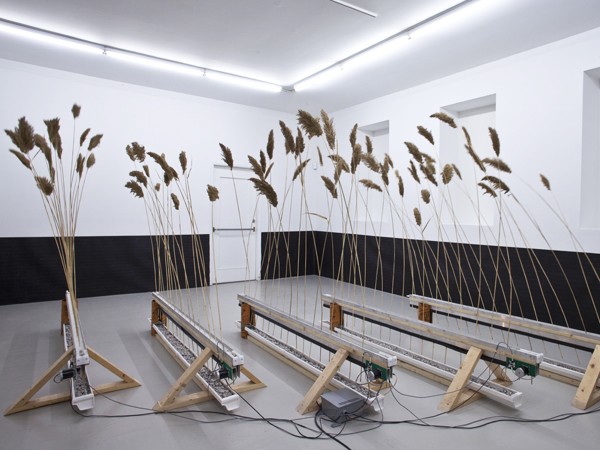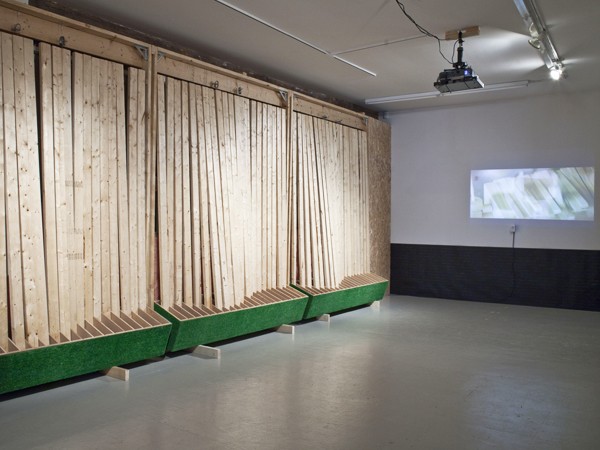According to Peter Zumthor, the materiality of architectural space should be defined by the sum of the perceived space not the materials or objects in isolation. This also should exist in the collective effect of the visual and acoustic qualities of the built materials under certain conditions of situation and time.1 Viewed in this way, the notion of materiality that plays a part in a given gallery space and that makes the visual and sound parameters interact is the occasion for revisiting Le long de la 20 en passant par la 15 an exhibition of Jonathan Villeneuve’s works presented at LA CHAMBRE BLANCHE from March 17 to April 17, 2011. Although the artist’s two electromechanical installations are a physical construction of various material and technological components, they also propose the elaboration of a system of interaction and interrelation: the materials become the players in a network of exchange and dialogue among the works’ various parts, between the installations and the viewer’s experience. These interactive properties develop with the movement that animates the machines, creating vibrations and undulations: they provide the material with the potential for expression, a poetic dimension.
Through the various exchanges, a dialogue is carried out between materiality and immateriality. We understand immateriality here as the continuation of materiality, as Florence de Mèredieu states, citing Ezio Manzini, “The new matter from which to draw inspiration no longer has the physicality of tangible material; it is presented instead as a combination of possibilities and performances, as the possible that emerges from the producible in a technical system capable of carrying out still more subtle manipulations.”2 Villeneuve’s installations propose a passage between these two states due to the notion of fragment and trace that they generate; and also, because immateriality is viewed as a material component of the works, which generates a sound environment.
Opening in the Materiality: Architecture as Fragment, Trace and Memory
Villeneuve’s works are structures in which the framework is exposed: the cogs that form its core are shown to the viewer and thus, the distinction between the inside and outside of the work is blurred. In other words, the frame that structures the installation becomes the work itself.
Villeneuve’s redefinition of the frame’s boundaries is revealed in Faire la vague (2009), one of the two structures in the exhibition that is both skeletal and colossal, constructed of solid material, in this case wood. This piece play on the boundaries of the support and act on the viewer’s perception, presenting a series of juxtaposed planks that move. Hence, the infrangible vision that this imposing wall could have generated is replaced with an image of instability, indeed material vulnerability, by cutting the material into beams that suggest a steady oscillation. Here, the architectural composition creates a fragility that is accentuated by this movement of the material. Both stable in its framework and instable in its movement, the work creates a paradox. The breaking up of this seemingly monumental structure displays, in fact, an animated materiality in which the whole gives way to fragmentation. The interstices make up the work: the openings, fractures or fissures form the core of the structure.
This architecture that seems to deconstruct gives way at first to a visual opening, as part of the physical and then psychological space of the gallery, filtering into the mental representations of the viewers who can place themselves either in front of Faire la vague (2009), catching sight through its rifts of Mouvement de masse (2010), the second structure in the exhibition, or else to move inside this second installation composed of grasses so that one can discover the frame. One way or the other, the viewer has a simultaneous encounter with the two electromechanical displays that both carry out continual movement. While Faire la vague uses natural wood elements to distort the initial appearance, integrating them into an elaborate composition, Mouvement de masse artificially confines fragments from nature, regularly aligned plant stems and through a mechanical process simulates the wind’s movement. Plants and wood are in dialogue then to produce both the work and its structure. Following this idea of voluntarily showing the armature, the electromechanical installations present the raw materials transformed without ornaments or artifice. The use of this material within the gallery lets one see a sociological dimension in the works, demonstrating the submission of nature that is now manipulated, mechanised, even artificially reconstructed in the gallery space. It is controlled and given regular movement, as we have seen, but it is alienating as well, recalling manufactured or mechanized work.
Villeneuve’s structures evoke the urban and rural environment, presenting fragments of organic and utilitarian elements, as if they had become a trace of nature, an exterior place transposed into the limited space of the gallery. The exhibition title, Le long de la 20 en passant par la 15, indicates the artist’s wish of bringing the works together, recalling the various natural components that border highways. These works seem like evidence of a past linked to a personal or collective history. The reminiscence and memory of similar temporal and spatial moments are recreated then in the memory of the visitor who has had the experience and can imagine them again through this setting, this time in a fictional way, through the constructions that act as a deconstructed narrative display.
Acoustic (Im)materiality: Sound as Interactive Material
While the spatial configuration of the moving installations presents a critical dimension, the work takes all its meaning from the sound aspect the machines produce, which add to the spatio-temporal reality the viewer experiences. Villeneuve had already experimented with notions of light and sound in the electromechanical installation Trace (2007) in which the light source acted as an intrinsic element of the work, supported by a rhythmical sound frame. He expanded this sound dimension in Faire la vague, which gives the viewer more than just an auditory setting, adding the creaking noise of the cogs and the interstices that, as explained previously, participate in deconstructing and fragmenting the built structure. In fact the materials knock together and produce a regular rhythmical background sound. Mouvement de masse creates similar sounds that immerse the viewer and detach the work from any mimetic sound references to the initial grass environment, asserting more the mechanized transformation that has occurred.
The importance given to sound attests to its legitimacy as a material, as a “plastic ingredient,” and diverts any possibility of relegating it to an accompanying tool, subjected to visual constructions.3 The sound substance perceived as autonomous material, the result of the moving mobiles, enables both simultaneity and a succession of various acoustic elements that are organized or at least, are blended together. In this way, a temporal dimension is inserted within the installation work and is part of the work’s sound structure. From this perspective, “the sound is to time what movement is to space, a principle of organization and of disorganization,” according to Florence de Mèredieu.4
These sound environments that mechanical sounds produce are capable, here again, of activating the viewer’s mnemonic faculties, which may associate these noises with recognized sonorities and visual images. Combined with moving material that recalls urban or rural settings, the installations increase the dramatization and illustrate a more deconstructed narrative. The viewer’s phenomenological experience, in short, is that of an immersive environment that succeeds wholly by emphasizing the sound material that the mechanical installation produces, favouring continual movement over the motionless object.
Passages
Jonathan Villeneuve’s architectural installations create an “impression of immateriality” that the viewer experiences: viewed as a counterpoint to the physical elements, the underlying parameters such as time, sound and movement, when combined, seem to construct the very finality of this mobile spectacle.5 This vision can be supported by Bergson’s thesis according to which the formal composition constructed in its static state becomes passage. In other words, in the perception of reality, according to Bergson, the legitimacy of form is denied its actual immobility for mobility: “There is no form, since form is immobile and the reality is movement. What is real is the continual change of form: form is only a snapshot view of a transition.”6 In this idea of instantaneity and mobility at the very core of exchanges, the boundaries between materiality and immateriality create ambiguity, they seem to become porous, indeed hybrids; the tangible and intangible elements merge to give the viewer’s experience its full potential.
- Zumthor, Peter. 2006, “Atmospheres: Architectural Environments: Surrounding Objects” in Dagmar Reinhardt and Joanne Jakovitch, “Trivet Fields: The Materiality of Interaction in Architectural Space”, Leonardo, Vol. 42, No. 3, p. 217.
- Manzini, Enzio. 1989, La Matière de l’invention. Paris: Centre Georges Pompidou editions, p. 52 quoted in Mèredieu, Florence de. 2008, L’Histoire matérielle et immatérielle de l’art. Paris: Larousse editions, p. 483.
- Mèredieu, Florence de. 2008, L’Histoire matérielle et immatérielle de l’art. Paris: Larousse editions, p. 548.
- Ibid., p. 542.
- Souriau explains that a material work may “try to give the impression of immateriality”. Souriau, Étienne. 1990, Vocabulaire d’esthétique. Paris: Presses Université de France, p. 910.
- Bergson, Henri. 1929, L’Évolution créatrice. Paris: Alcan editions, p. 334.



